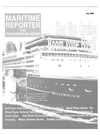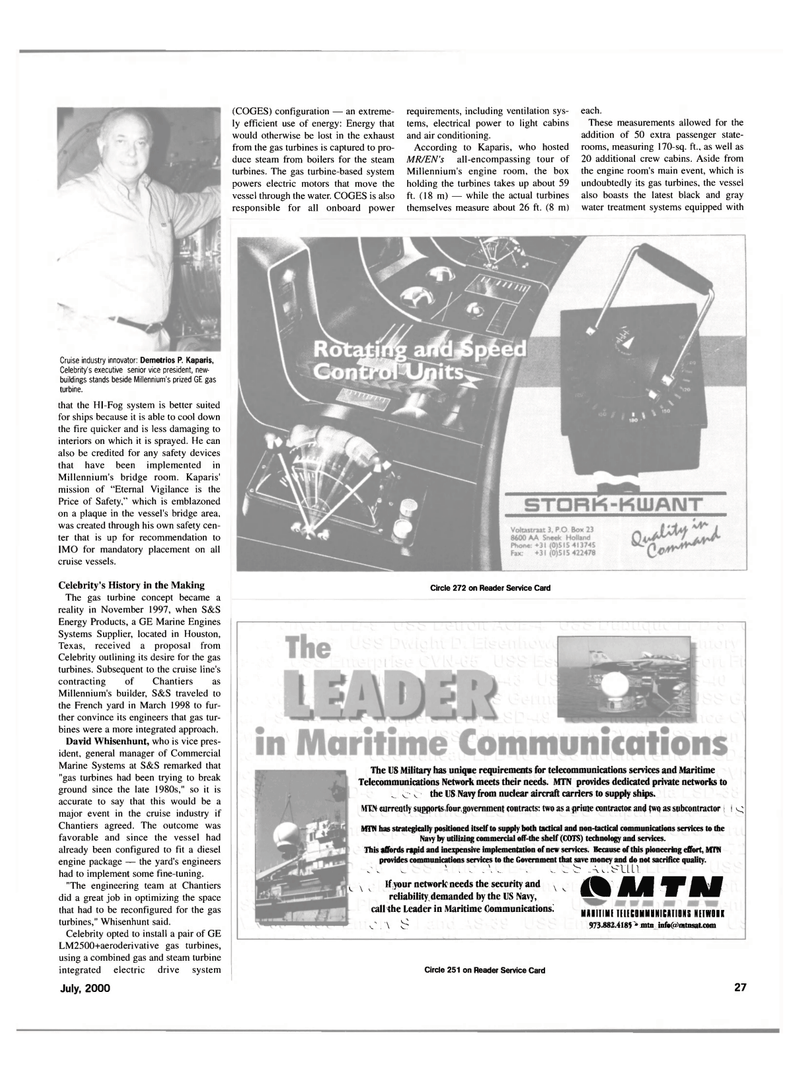
Page 27: of Maritime Reporter Magazine (July 2000)
Read this page in Pdf, Flash or Html5 edition of July 2000 Maritime Reporter Magazine
Cruise industry innovator: Demetrios P. Kaparis,
Celebrity's executive senior vice president, new- buildings stands beside Millennium's prized GE gas turbine. that the HI-Fog system is better suited for ships because it is able to cool down the fire quicker and is less damaging to interiors on which it is sprayed. He can also be credited for any safety devices that have been implemented in
Millennium's bridge room. Kaparis' mission of "Eternal Vigilance is the
Price of Safety," which is emblazoned on a plaque in the vessel's bridge area, was created through his own safety cen- ter that is up for recommendation to
IMO for mandatory placement on all cruise vessels.
Celebrity's History in the Making
The gas turbine concept became a reality in November 1997, when S&S
Energy Products, a GE Marine Engines
Systems Supplier, located in Houston,
Texas, received a proposal from
Celebrity outlining its desire for the gas turbines. Subsequent to the cruise line's contracting of Chantiers as
Millennium's builder, S&S traveled to the French yard in March 1998 to fur- ther convince its engineers that gas tur- bines were a more integrated approach.
David Whisenhunt, who is vice pres- ident, general manager of Commercial
Marine Systems at S&S remarked that "gas turbines had been trying to break ground since the late 1980s," so it is accurate to say that this would be a major event in the cruise industry if
Chantiers agreed. The outcome was favorable and since the vessel had already been configured to fit a diesel engine package — the yard's engineers had to implement some fine-tuning. "The engineering team at Chantiers did a great job in optimizing the space that had to be reconfigured for the gas turbines," Whisenhunt said.
Celebrity opted to install a pair of GE
LM2500+aeroderivative gas turbines, using a combined gas and steam turbine integrated electric drive system (COGES) configuration — an extreme- ly efficient use of energy: Energy that would otherwise be lost in the exhaust from the gas turbines is captured to pro- duce steam from boilers for the steam turbines. The gas turbine-based system powers electric motors that move the vessel through the water. COGES is also responsible for all onboard power requirements, including ventilation sys- tems, electrical power to light cabins and air conditioning.
According to Kaparis, who hosted
MR/EN's all-encompassing tour of
Millennium's engine room, the box holding the turbines takes up about 59 ft. (18 m) — while the actual turbines themselves measure about 26 ft. (8 m)
Circle 272 on Reader Service Card
Circle 251 on Reader Service Card each.
These measurements allowed for the addition of 50 extra passenger state- rooms, measuring 170-sq. ft., as well as 20 additional crew cabins. Aside from the engine room's main event, which is undoubtedly its gas turbines, the vessel also boasts the latest black and gray water treatment systems equipped with
The US Military has unique requirements for telecommunications services and Maritime
Telecommunications Network meets their needs. MTN provides dedicated private networks to . S the US Navy from nuclear aircraft carriers to supply ships.
MTV currently supports four government contracts: two as a prime contractor and (wq as subcontractor j ^
MTN has strategically positioned itself to supply both tactical and non-tactical communications services to the
Navy by utilizing commercial off-the shelf (COTS) technology and services.
This affords rapid and inexpensive implementation of new services. Because of this pioneering effort, MTN provides communications services to the Government that save money and do not sacrifice quality. ,-v v ~ \ V, bb . L Willi . .
V. \ v If your network needs the security and reliability demanded by the US Navy, \ V call the Leader in Maritime Communications; c \ S
AMTM
MARITIME TELECOMMUNICATIONS NETWORK 973.882.4185 > mtn inf®(«>mtnsatcom
July, 2000 27

 26
26

 28
28
